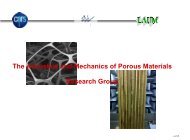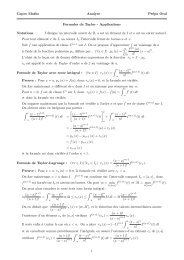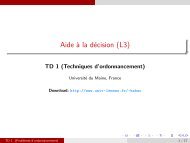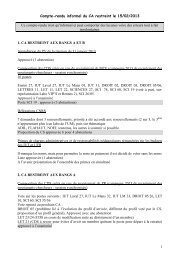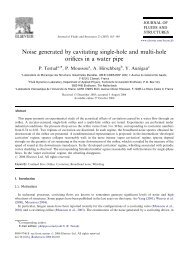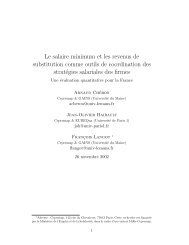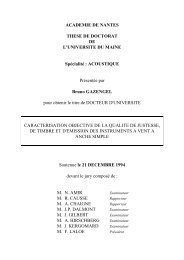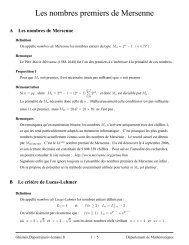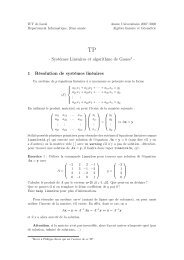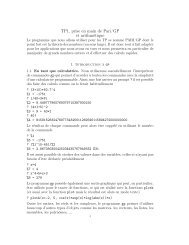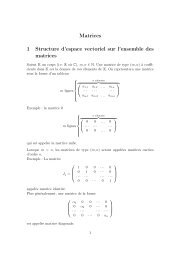Electrical conduction and Joule effect in one-dimensional chains of ...
Electrical conduction and Joule effect in one-dimensional chains of ...
Electrical conduction and Joule effect in one-dimensional chains of ...
Create successful ePaper yourself
Turn your PDF publications into a flip-book with our unique Google optimized e-Paper software.
<strong>Electrical</strong> <strong>conduction</strong> <strong>in</strong> cha<strong>in</strong>s <strong>of</strong> beadsFig. 6 Variation <strong>of</strong> voltage U as a function <strong>of</strong> current I . Cha<strong>in</strong> <strong>of</strong> 5sta<strong>in</strong>less beads (diameter 11 mm). Comparison between experimentaldata (×) <strong>and</strong> analytical model (−) with the adjusted parameters (Eq. 6).Decreas<strong>in</strong>g current: α ↓ =+1.1×10 −3 <strong>and</strong> β ↓ = −6.9×10 −4 ;<strong>in</strong>creas<strong>in</strong>gcurrent α ↑ =+2.1 × 10 −3 <strong>and</strong> β ↑ =+7.0 × 10 −4<strong>of</strong> beads has a slightly higher resistance to the flow <strong>of</strong> electriccharge R lc↑ ≃ 2.1 (part DE, Figs. 2 <strong>and</strong> 6) thanforthe weak decreas<strong>in</strong>g currents R lc↓ ≃ 2.0 (part CD, Fig. 6).This difference is ma<strong>in</strong>ly due to the thermal delays associatedto the relatively fast evolution <strong>of</strong> the electric current. Indeed,for a given small current <strong>in</strong> the decreas<strong>in</strong>g phase (part CD),the bulk <strong>of</strong> the beads presents a lower temperature <strong>and</strong> thus alower measured voltage compared to those <strong>of</strong> the <strong>in</strong>creas<strong>in</strong>gphase <strong>of</strong> current (part DE). Thus the cha<strong>in</strong> <strong>of</strong> beads has anelectromechanical behavior <strong>of</strong> hysteretic type for which thevoltage–current characteristics present a loop (Fig. 6). Thelarger is the loop, the greater is the thermal energy released<strong>in</strong> the cha<strong>in</strong> <strong>and</strong> consequently the more the beads warm up.These phenomena are more pronounced for cycles <strong>of</strong> higherelectric currents, as shown later <strong>in</strong> Fig. 7.4 Model<strong>in</strong>g <strong>of</strong> the hysteretic behavior CD-DEIn the follow<strong>in</strong>g, the measured hysteretic current–voltagecharacteristics (parts CD <strong>and</strong> DE) are compared with thoseresult<strong>in</strong>g from an analytical model [7,8,12–14,24].The two beads <strong>in</strong> contact are considered as two homogeneous<strong>and</strong> isotropic metal conductors with large dimensionscompared to the contact radius. The electric currentgoes <strong>in</strong>to <strong>and</strong> leaves by surface ends S 1 <strong>and</strong> S 2 (Fig. 3).The heat flux only runs out through these same surfaces.For side surfaces, the losses by <strong>conduction</strong>, convection orradiation are neglected. It should be noted that the thermalconductivities <strong>of</strong> the air (λ air ≃ 0.026 W m −1 K −1 )<strong>and</strong>thePVC tubes (λ PVC ≃ 0.16 W m −1 K −1 )aremuchsmallerthan thermal conductivity with<strong>in</strong> the sta<strong>in</strong>less steel (λ steel ≃15 W m −1 K −1 ).Equipotential surfaces <strong>in</strong> the whole bead are also isothermalsurfaces. The two networks <strong>of</strong> equipotential <strong>and</strong>Fig. 7 Voltage U,currentI <strong>and</strong> power P = UI for a cha<strong>in</strong> <strong>of</strong> 3 sta<strong>in</strong>lessbeads (diameter 11 mm) submitted to four successive cycles <strong>of</strong>current. ↗ <strong>and</strong> ↖:<strong>in</strong>creas<strong>in</strong>gcurrents;↙ <strong>and</strong> ↘:decreas<strong>in</strong>gcurrentsisotherm present values that depend on the boundary conditionsimposed on the potential <strong>and</strong> the temperature. Moreover,the equipotential network is <strong>in</strong>dependent <strong>of</strong> the heatflux. Tak<strong>in</strong>g <strong>in</strong>to account the previous considerations, phenomenaare considered <strong>in</strong> a steady-state, <strong>and</strong> the equation<strong>of</strong> energy balance leads to the Kohlrausch relation. It providesthe follow<strong>in</strong>g expression for the potential difference ubetween the contact surface <strong>and</strong> the surface at temperatureT :u 2 (T, T c ) = 2∫ T cTρ(θ)λ(θ) dθ, (3)where T c , λ <strong>and</strong> ρ are respectively the temperature <strong>of</strong> thecontact surface, the thermal conductivity <strong>and</strong> the electricalresistivity.The conservation equation <strong>of</strong> the charged particle flow1 −−→ρ(T 0 ) grad[vlc (T 0 )]=ρ(T 1 −−→) grad[u(T )] allows to obta<strong>in</strong> thepotential difference v lc (between the contact surface <strong>and</strong> surfaceS 0 )forweakelectricalcurrentswithnoheatflux:∫ T cλ(θ)v lc (T 0 , T c ) = ρ(T 0 ) dθ. (4)U(θ)T 0The dependencies <strong>of</strong> the electrical resistivity <strong>and</strong> thermalconductivity on the temperature are considered l<strong>in</strong>ear <strong>and</strong>respectively <strong>of</strong> the form:ρ(T ) = ρ r {1 + α(T − T r )}[ m],λ(T ) = λ r {1 + β(T − T r )} [Wm −1 K −1 ], (5)where ρ r ≃ 0.810 −6 m<strong>and</strong>λ r ≃ 15 W m −1 K −1 arereference values <strong>of</strong> the electrical resistivity <strong>and</strong> thermal conductivityat temperature T r ≃ 293 K [22,25]. The values <strong>of</strong>coefficients α <strong>and</strong> β can be obta<strong>in</strong>ed by m<strong>in</strong>imization <strong>of</strong> thedifference between the voltage–current (U −I ) model (Eq. 6)<strong>and</strong> the experimental data. It is necessary because <strong>of</strong> the lack123



